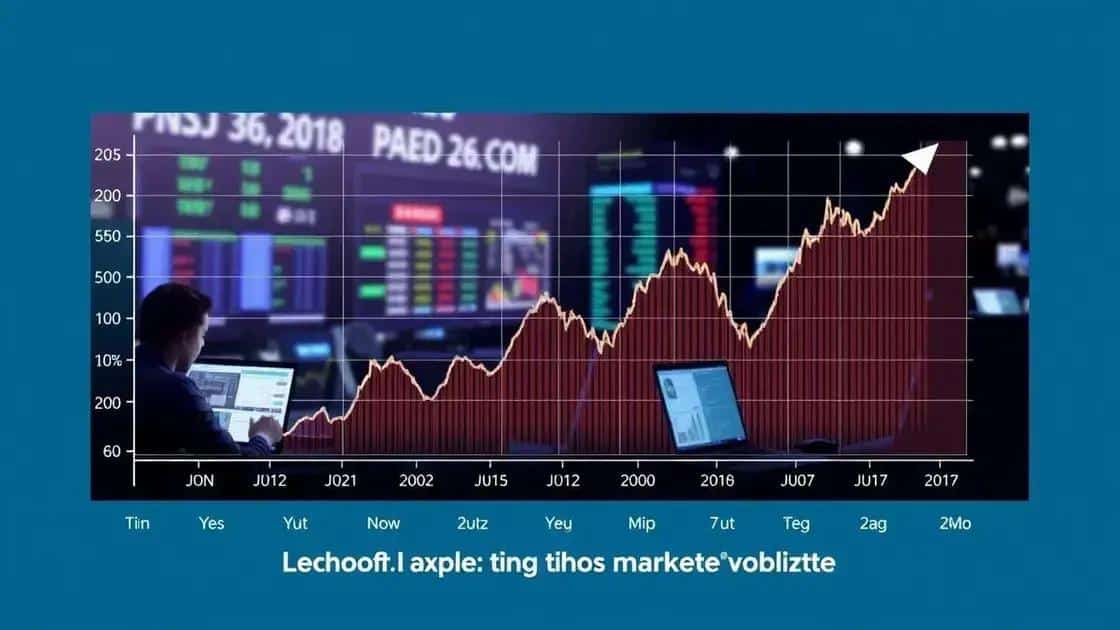April 2025 financial volatility prompts investor concern

Anúncios
April 2025 financial volatility prompts investor concern, leading to cautious strategies, increased risk aversion, and a reevaluation of investment approaches to navigate uncertainty and protect assets.
April 2025 financial volatility prompts investor concern as markets show unexpected fluctuations. What does this mean for you? Let’s dive into how these changes can impact your investments.
Current trends in the financial markets
Understanding the current trends in the financial markets is essential for investors. As we analyze recent data, we can observe shifts that impact decision-making. Increased volatility is a major concern, but what does it mean for you?
Key Indicators to Watch
Several factors contribute to market trends today. Keeping an eye on key indicators helps you make informed choices. Here are some important elements to consider:
- Interest rates: Changes can influence borrowing costs and consumer spending.
- Inflation rates: Rising inflation can erode purchasing power.
- Employment data: Job growth signals economic health.
- Global events: Geopolitical tensions can cause market fluctuations.
The current landscape shows increased market volatility affecting various sectors. Many investors are uncertain about how to proceed. Staying informed is crucial. Trends such as rising energy prices and supply chain disruptions impact businesses globally, leading to unpredictable outcomes.
Sector Performance Analysis
Looking closer at different sectors is beneficial. For example, technology stocks have faced both gains and losses due to rapid developments. Meanwhile, the healthcare sector remains relatively stable amid fluctuations. Adapting your strategy requires understanding these sector performances.
Investors are also paying attention to emerging markets. These markets can offer new opportunities, though they come with inherent risks. Key geographical regions provide insights into where growth might happen and how international relations play a role in financial health.
As April 2025 unfolds, investors must stay alert. Keeping track of daily market movements becomes essential. Resources like financial news, analytics, and market reports can help guide your decisions.
Investor reactions and sentiments

Investor reactions and sentiments play a crucial role in shaping market dynamics. During times of uncertainty, such as the April 2025 financial volatility, understanding how investors feel can provide valuable insights. Their emotions often drive decisions, impacting market movements considerably.
Current Sentiments
Recent surveys show that many investors are feeling anxious. This apprehension could lead to increased selling pressure or a cautious approach to new investments. Key factors influencing these sentiments include:
- Market fluctuations: Continuous ups and downs lead to uncertainty.
- Economic indicators: Changes in unemployment rates and inflation can heighten concern.
- Political events: Unrest or policy changes impact investor confidence.
The feelings of investors are complex. Some may see opportunities amidst the chaos, while others retreat to safer options. This duality illustrates the varying perspectives that exist in the market.
Behavioral Responses
Reactions often dictate behavior. Many investors adopt a risk-averse strategy during turbulent times. This shift can lead to pulling money from stocks and investing in safer assets like bonds or commodities.
However, not all investors react the same way. Some, known as contrarians, view market turbulence as an opportunity. They might increase their investments, hoping to capitalize on lower prices. This dynamic creates a fascinating tension within the market.
Additionally, social media plays a significant role in shaping sentiments. News spreads quickly, and investor emotions can shift based on online discussions. Platforms that promote real-time information can exacerbate feelings of panic or optimism.
Strategies for mitigating risks
In today’s financial landscape, devising strategies for mitigating risks is essential for every investor. As the market experiences considerable fluctuations, understanding how to protect your investments can lead to better outcomes. Following effective strategies can provide you with peace of mind.
Diversification Techniques
Diversification is one of the most reliable strategies to reduce risk. By spreading your investments across different asset classes, you can lessen the impact of any single asset’s poor performance. Some key diversification techniques include:
- Investing in a mix of stocks, bonds, and commodities.
- Allocating funds across various industries to minimize sector risk.
- Incorporating international investments to hedge against domestic downturns.
This approach not only smooths out returns but can also enhance overall portfolio performance. By not putting all your eggs in one basket, you can better navigate market volatility.
Use of Stop-Loss Orders
Implementing stop-loss orders is another effective tactic for safeguarding investments. A stop-loss order triggers automatically, selling a security when it reaches a specific price point. This can help limit potential losses during downturns. Here are some benefits:
- Provides a predefined exit strategy.
- Reduces emotional decision-making during market volatility.
- Helps to maintain a disciplined investment approach.
Investors should regularly reassess and adjust their stop-loss points according to market conditions. This vigilance can make a significant difference when swift decisions are required.
Additionally, keep an eye on market trends and news. Staying informed about economic changes, global events, and company-specific updates can help you react swiftly to protect your investments. Regularly evaluating your portfolio will enable you to stay aligned with your financial goals.
Long-term implications of market volatility

The long-term implications of market volatility are significant and can shape investor strategies for years to come. Understanding these impacts helps in planning for a stable financial future. When markets experience prolonged fluctuations, investors must assess how it affects their assets and overall portfolio.
Impact on Investment Strategies
One of the most noticeable effects of market volatility is the shift in investment strategies. Investors may become more cautious, leading to a tendency to prefer safer assets such as bonds or blue-chip stocks. This cautious approach can impact returns over time.
- Risk aversion increases among investors.
- Long-term investments may shift towards conservative assets.
- Growth-focused strategies might face challenges compared to defensive investing.
Additionally, market volatility can incentivize investors to reassess their risk tolerance. Many may opt to hold cash or invest in alternative assets like real estate, which can provide a buffer against market fluctuations.
Effects on Economic Growth
Long-term market volatility can also influence broader economic growth. Prolonged market instability can dampen consumer confidence and lead to reduced spending. When individuals and businesses pull back on expenditure, economic growth may slow significantly.
Moreover, companies may rethink their expansion plans due to uncertainty. This hesitation can lead to diminished job creation and slower advancements in innovation. It’s essential to recognize how volatility can create a ripple effect throughout the economy.
As markets continue to fluctuate, understanding these long-term implications helps investors navigate uncertain waters. Staying informed about market trends and adjusting strategies accordingly can position investors better for future resilience.
FAQ – Frequently Asked Questions about Financial Volatility
What causes financial market volatility?
Financial market volatility can be caused by various factors, including economic data releases, geopolitical tensions, changes in interest rates, and investor sentiment.
How can investors protect themselves from market volatility?
Investors can protect themselves by diversifying their portfolios, using stop-loss orders, and maintaining a risk management strategy to mitigate potential losses.
What are the long-term implications of market volatility?
Long-term implications of market volatility include shifts in investment strategies, potential economic slowdown, and changes in consumer confidence affecting spending.
How do investor emotions impact market movements?
Investor emotions, such as fear or greed, can significantly impact market movements, driving decisions that lead to increased buying or selling pressure during volatile periods.






